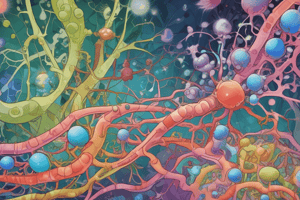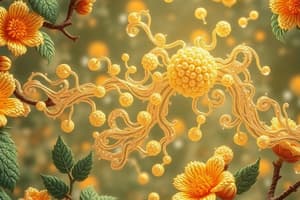Podcast
Questions and Answers
What is the primary form in which newly synthesized fatty acids exist?
What is the primary form in which newly synthesized fatty acids exist?
- As phospholipids
- As triglycerides
- As free fatty acids
- As acyl-CoA esters (correct)
What catalyzes the process of biosynthesis of fatty acids?
What catalyzes the process of biosynthesis of fatty acids?
- Acetyl-CoA carboxylase
- Carnitine palmitoyltransferase
- Malonyl-CoA ligase
- Fatty-acid synthase complex (correct)
How are 2-carbon units added during fatty acid biosynthesis?
How are 2-carbon units added during fatty acid biosynthesis?
- Via the conversion of acyl-CoA to glycerol
- Through the action of malonyl-CoA (correct)
- By direct methylation of fatty acids
- By hydrolysis of triglycerides
What is the role of Acetyl-CoA in fatty acid biosynthesis?
What is the role of Acetyl-CoA in fatty acid biosynthesis?
What occurs to free fatty acid concentrations in most cells?
What occurs to free fatty acid concentrations in most cells?
What is the role of biotin in the carboxylation of acetyl-CoA?
What is the role of biotin in the carboxylation of acetyl-CoA?
Which of the following products is generated after the condensation step that involves β-ketoacyl-ACP synthase?
Which of the following products is generated after the condensation step that involves β-ketoacyl-ACP synthase?
Which steps in fatty acid biosynthesis involve the reduction of carbonyl groups?
Which steps in fatty acid biosynthesis involve the reduction of carbonyl groups?
What drives the β-ketoacyl-ACP synthase reaction during fatty acid synthesis?
What drives the β-ketoacyl-ACP synthase reaction during fatty acid synthesis?
What is the primary intermediate produced from the carboxylation of Acetyl-CoA?
What is the primary intermediate produced from the carboxylation of Acetyl-CoA?
What is the primary function of lipids in the body?
What is the primary function of lipids in the body?
Which hormone is NOT mentioned as triggering the release of fatty acids from adipose tissue?
Which hormone is NOT mentioned as triggering the release of fatty acids from adipose tissue?
During beta oxidation, what is removed from fatty acids in the process?
During beta oxidation, what is removed from fatty acids in the process?
What role do pancreatic lipases play in fat digestion?
What role do pancreatic lipases play in fat digestion?
What is the energy yield from fatty acid oxidation compared to carbohydrate oxidation?
What is the energy yield from fatty acid oxidation compared to carbohydrate oxidation?
Which of the following is responsible for hydrolyzing phosphoacylglycerols?
Which of the following is responsible for hydrolyzing phosphoacylglycerols?
Where does the degradation of fatty acids primarily occur?
Where does the degradation of fatty acids primarily occur?
What type of enzyme is fatty acid synthase (FAS)?
What type of enzyme is fatty acid synthase (FAS)?
What is produced during the last β-oxidation cycle of a fatty acid with an odd number of carbons?
What is produced during the last β-oxidation cycle of a fatty acid with an odd number of carbons?
How much ATP is generated from one molecule of palmitic acid during oxidation?
How much ATP is generated from one molecule of palmitic acid during oxidation?
What must occur to convert an unsaturated fatty acid to acetyl-CoA during its oxidation?
What must occur to convert an unsaturated fatty acid to acetyl-CoA during its oxidation?
Which enzyme is primarily involved in the isomerization of unsaturated fatty acids?
Which enzyme is primarily involved in the isomerization of unsaturated fatty acids?
In terms of energy yield, how does the oxidation of unsaturated fatty acids compare to that of saturated fatty acids with the same number of carbons?
In terms of energy yield, how does the oxidation of unsaturated fatty acids compare to that of saturated fatty acids with the same number of carbons?
What is the role of propionyl-CoA in metabolic processes?
What is the role of propionyl-CoA in metabolic processes?
What is the free energy release of ATP in kJ/mol?
What is the free energy release of ATP in kJ/mol?
How is acyl-CoA transferred into the mitochondria for fatty acid biosynthesis?
How is acyl-CoA transferred into the mitochondria for fatty acid biosynthesis?
What is released during the process initiated by the 2-C unit?
What is released during the process initiated by the 2-C unit?
What type of bond is formed during fatty acid activation?
What type of bond is formed during fatty acid activation?
How many ATP equivalents are consumed in the formation of a CoA ester during fatty acid activation?
How many ATP equivalents are consumed in the formation of a CoA ester during fatty acid activation?
What is the function of Carnitine in acyl-CoA transfer?
What is the function of Carnitine in acyl-CoA transfer?
Which enzyme has specificity for acyl groups between 14 and 18 carbons long?
Which enzyme has specificity for acyl groups between 14 and 18 carbons long?
What is the primary function of b-Oxidation?
What is the primary function of b-Oxidation?
Which step of b-Oxidation involves the formation of a carbon-carbon double bond?
Which step of b-Oxidation involves the formation of a carbon-carbon double bond?
What occurs during the acyl-CoA dehydrogenase reaction?
What occurs during the acyl-CoA dehydrogenase reaction?
What is the product formed from the reaction of trans-enoyl-CoA derivatives in the b-oxidation process?
What is the product formed from the reaction of trans-enoyl-CoA derivatives in the b-oxidation process?
Which statement accurately describes the function of L-hydroxyacyl-CoA dehydrogenase?
Which statement accurately describes the function of L-hydroxyacyl-CoA dehydrogenase?
What is produced when a tetrahedral intermediate decomposes during the !-ketothiolase reaction?
What is produced when a tetrahedral intermediate decomposes during the !-ketothiolase reaction?
What is the main reason ketone bodies are formed during fatty acid breakdown?
What is the main reason ketone bodies are formed during fatty acid breakdown?
What are the primary ketone bodies produced in the liver?
What are the primary ketone bodies produced in the liver?
What is the total ATP yield from one molecule of stearic acid through complete oxidation, considering all steps?
What is the total ATP yield from one molecule of stearic acid through complete oxidation, considering all steps?
Which molecule serves as a precursor to form acetyl-CoA in the initial stages of fatty acid oxidation?
Which molecule serves as a precursor to form acetyl-CoA in the initial stages of fatty acid oxidation?
What is the process by which fatty acids are activated before catabolism?
What is the process by which fatty acids are activated before catabolism?
In the context of energy yield from fatty acid oxidation, what does 1 NADH yield in terms of ATP equivalents?
In the context of energy yield from fatty acid oxidation, what does 1 NADH yield in terms of ATP equivalents?
Flashcards
What is the name of the process that breaks down fatty acids?
What is the name of the process that breaks down fatty acids?
Beta-oxidation is a metabolic process that breaks down fatty acids into acetyl-CoA, which can then be used to generate energy through the citric acid cycle and oxidative phosphorylation.
What is the starting molecule for beta-oxidation?
What is the starting molecule for beta-oxidation?
Acyl-CoA is the activated form of a fatty acid that is used as the starting molecule for beta-oxidation.
What is the role of carnitine in beta-oxidation?
What is the role of carnitine in beta-oxidation?
Carnitine is a molecule that helps to transport acyl-CoA across the inner mitochondrial membrane, where beta-oxidation takes place.
What is the first step of beta-oxidation?
What is the first step of beta-oxidation?
Signup and view all the flashcards
What is the second step of beta-oxidation?
What is the second step of beta-oxidation?
Signup and view all the flashcards
What is the third step of beta-oxidation?
What is the third step of beta-oxidation?
Signup and view all the flashcards
What is the fourth step of beta-oxidation?
What is the fourth step of beta-oxidation?
Signup and view all the flashcards
Where does beta-oxidation occur?
Where does beta-oxidation occur?
Signup and view all the flashcards
Fatty acid sources
Fatty acid sources
Signup and view all the flashcards
β-oxidation
β-oxidation
Signup and view all the flashcards
Activation of fatty acids
Activation of fatty acids
Signup and view all the flashcards
Four steps of β-oxidation
Four steps of β-oxidation
Signup and view all the flashcards
Energy yield from β-oxidation
Energy yield from β-oxidation
Signup and view all the flashcards
Odd-chain fatty acid oxidation
Odd-chain fatty acid oxidation
Signup and view all the flashcards
Unsaturated fatty acid oxidation
Unsaturated fatty acid oxidation
Signup and view all the flashcards
Fatty acid biosynthesis
Fatty acid biosynthesis
Signup and view all the flashcards
Beta-oxidation
Beta-oxidation
Signup and view all the flashcards
Enzymes involved in beta-oxidation
Enzymes involved in beta-oxidation
Signup and view all the flashcards
Role of acyl-CoA dehydrogenase
Role of acyl-CoA dehydrogenase
Signup and view all the flashcards
Enoyl-CoA hydratase (crotonase) reaction
Enoyl-CoA hydratase (crotonase) reaction
Signup and view all the flashcards
L-hydroxyacyl-CoA dehydrogenase reaction
L-hydroxyacyl-CoA dehydrogenase reaction
Signup and view all the flashcards
Beta-ketothiolase reaction
Beta-ketothiolase reaction
Signup and view all the flashcards
Ketone bodies
Ketone bodies
Signup and view all the flashcards
Number of beta-oxidation cycles
Number of beta-oxidation cycles
Signup and view all the flashcards
Energy yield from fatty acid oxidation
Energy yield from fatty acid oxidation
Signup and view all the flashcards
Activation step of fatty acid oxidation
Activation step of fatty acid oxidation
Signup and view all the flashcards
Propionyl-CoA
Propionyl-CoA
Signup and view all the flashcards
Odd-Numbered Fatty Acid
Odd-Numbered Fatty Acid
Signup and view all the flashcards
Unsaturated Fatty Acid
Unsaturated Fatty Acid
Signup and view all the flashcards
Isomerase
Isomerase
Signup and view all the flashcards
Succinyl-CoA
Succinyl-CoA
Signup and view all the flashcards
Carnitine Carrier
Carnitine Carrier
Signup and view all the flashcards
What is the first step in fatty acid biosynthesis?
What is the first step in fatty acid biosynthesis?
Signup and view all the flashcards
What enzyme catalyzes the first step of fatty acid biosynthesis?
What enzyme catalyzes the first step of fatty acid biosynthesis?
Signup and view all the flashcards
What is the role of biotin in fatty acid biosynthesis?
What is the role of biotin in fatty acid biosynthesis?
Signup and view all the flashcards
β-ketoacyl-ACP synthase
β-ketoacyl-ACP synthase
Signup and view all the flashcards
What is the purpose of the decarboxylation in the β-ketoacyl-ACP synthase reaction?
What is the purpose of the decarboxylation in the β-ketoacyl-ACP synthase reaction?
Signup and view all the flashcards
Fatty Acid Synthesis Location
Fatty Acid Synthesis Location
Signup and view all the flashcards
What is the starting molecule for fatty acid biosynthesis?
What is the starting molecule for fatty acid biosynthesis?
Signup and view all the flashcards
What is the role of malonyl-CoA in fatty acid biosynthesis?
What is the role of malonyl-CoA in fatty acid biosynthesis?
Signup and view all the flashcards
How many carbons are added in each cycle of fatty acid biosynthesis?
How many carbons are added in each cycle of fatty acid biosynthesis?
Signup and view all the flashcards
What is the primary enzyme involved in fatty acid biosynthesis?
What is the primary enzyme involved in fatty acid biosynthesis?
Signup and view all the flashcards
Study Notes
Beta Oxidation and Fatty Acid Synthesis
- Fatty acids are obtained from dietary intake and adipose tissue
- In the diet and in adipose tissue, most fats are triglycerides
- Hormones like glucagon, epinephrine, and ACTH initiate the release of fatty acids from adipose tissue
- Lipids store and generate energy
- Fatty acids store a high amount of energy
- The energy yield from fatty acid oxidation is greater than that from carbohydrate oxidation
- Fatty acids have mostly highly reduced carbon chains (-CH2-) which, when oxidized, yield high energy
- Fatty acids pack more densely in storage tissues
Fatty Acid Sources
- Fatty acids are sourced from food and adipose tissue
Beta Oxidation
- Beta oxidation is a series of reactions that cleave carbon atoms two at a time from the carboxyl end of a fatty acid
- The complete cycle requires four enzymes
- Reaction 1: Oxidation of the α,β carbon-carbon single bond to a carbon-carbon double bond
- Reaction 2: Hydration of the carbon-carbon double bond
- Reaction 3: Oxidation of the β-hydroxyl group to a carbonyl group
- Reaction 4: Cleavage of the carbon chain by a reverse Claisen reaction
Fatty Acid Activation
- Fatty acid oxidation begins with activation
- A thioester bond forms between the acyl group of the fatty acid and the thiol of CoA-SH
Fatty Acid Activation - Mechanism
- ATP provides energy for activation
- An enzyme-bound acyl-adenylate intermediate is formed
- A transient tetrahedral intermediate forms
- Fatty acyl-CoA is formed
Fatty Acid Activation - Energy
- The formation of a CoA ester is energetically expensive
- The free energy change during ATP hydrolysis is barely enough to break even
- Subsequent hydrolysis of PPi drives the reaction forward
- Approximately 2 ATP are used
The Role of Carnitine
- Acyl-CoA crosses the outer mitochondrial membrane but not the inner one
- The acyl group is transferred to carnitine, transported across the inner mitochondrial membrane
- Carnitine palmitoyltransferase (CPT-1) has specificity for acyl groups between 14 and 18 carbons
- In the matrix, acylcarnitine exchanges with mitochondrial CoA-SH to reform acyl-CoA
Oxidation of Odd-Numbered Fatty Acids
- The last cycle of beta oxidation of a fatty acid with an odd number of carbons yields propionyl-CoA instead of acetyl-CoA
- Propionyl-CoA can be converted to succinyl-CoA
Oxidation of Unsaturated Fatty Acids
- Cis-trans isomerization is required to convert unsaturated fatty acids to acetyl-CoA
- This enzyme is known as an isomerase
- Oxidation of unsaturated fatty acids doesn't generate as much ATP relative to saturated fatty acids with the same number of carbons
Fatty Acid Biosynthesis
- Fatty acid biosynthetic reactions occur in the cytosol
- Acetyl-CoA is transferred into mitochondria by the Carnitine carrier
- Acyl-CoA (nC) will be oxidized/broken down to Acetyl-CoA (2C), which is then transported out into the cytosol
Fatty Acid Biosynthesis Steps
- Acetyl-CoA (2C) + HCO3⁻ → Malonyl-CoA (3C)
- Acetyl-CoA (2C) + Malonyl-CoA (3C) →
- Reduction of the β-carbonyl group
- Dehydration to form a,β double bond C=C
- Reduction of the double bond to form saturated C chain
- Butyryl-ACP (4C) + Malonyl-CoA (3C) → ...
- [repeat steps 3 to 5] → Hexanoyl-ACP(6C) + CO2
- ....[repeat steps 3 to 5] → Acyl-ACP(nC)
Step 1: Acetyl-CoA Carboxylase (ACC)
- Carboxylation of acetyl-CoA occurs in the cytosol
- Catalyzed by acetyl-CoA carboxylase
- Biotin is an important cofactor
- Malonyl-CoA is the key intermediate produced
Step 2: 6-Ketoacyl-ACP synthase
- Acetyl activation
- Malonyl activation
- Condensation
Step 3-5
- Reduction (KR enzyme)
- Dehydration (HD enzyme)
- Reduction (ER enzyme)
Step 6 to n: Repeat adding 2 C
- Chain lengthening
- The chain is elongated by the addition of two-carbon units
- Fatty acids exist as acyl-CoA esters
Regulation
- Regulation mechanisms involve acetyl-CoA, ACC, AMPK, malonyl-CoA and the fatty acid synthesis and beta-oxidation processes
- Regulation is affected by abundant nutrients and ATP, as well as low nutrients and ATP
Summary
- Acetyl-CoA is transported to the cytosol and converted to malonyl-CoA
- Fatty acid biosynthesis proceeds through carbon unit additions
- The process is catalyzed by the fatty-acid synthase complex
Energy Yield from Fatty Acid Oxidation
- The oxidation of a fatty acid or molecule yields ATP.
Sites of Fatty Acid Metabolism in an Animal Cell
- Mitochondria
- Endoplasmic reticulum (ER)
- Cytosol
Studying That Suits You
Use AI to generate personalized quizzes and flashcards to suit your learning preferences.




